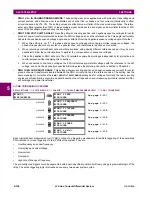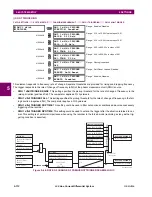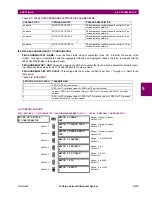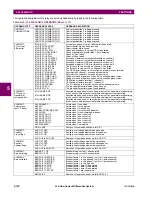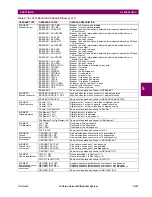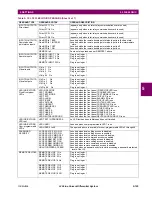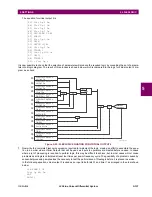
5-118
L30 Line Current Differential System
GE Multilin
5.5 FLEXLOGIC
5 SETTINGS
5
5.5FLEXLOGIC
5.5.1 INTRODUCTION TO FLEXLOGIC
To provide maximum flexibility to the user, the arrangement of internal digital logic combines fixed and user-programmed
parameters. Logic upon which individual features are designed is fixed, and all other logic, from digital input signals through
elements or combinations of elements to digital outputs, is variable. The user has complete control of all variable logic
through FlexLogic. In general, the system receives analog and digital inputs which it uses to produce analog and digital out-
puts. The major sub-systems of a generic UR-series relay involved in this process are shown below.
Figure 5–48: UR ARCHITECTURE OVERVIEW
The states of all digital signals used in the L30 are represented by flags (or FlexLogic operands, which are described later
in this section). A digital “1” is represented by a 'set' flag. Any external contact change-of-state can be used to block an ele-
ment from operating, as an input to a control feature in a FlexLogic equation, or to operate a contact output. The state of the
contact input can be displayed locally or viewed remotely via the communications facilities provided. If a simple scheme
where a contact input is used to block an element is desired, this selection is made when programming the element. This
capability also applies to the other features that set flags: elements, virtual inputs, remote inputs, schemes, and human
operators.
If more complex logic than presented above is required, it is implemented via FlexLogic. For example, if it is desired to have
the closed state of contact input H7a and the operated state of the phase undervoltage element block the operation of the
phase time overcurrent element, the two control input states are programmed in a FlexLogic equation. This equation ANDs
the two control inputs to produce a virtual output which is then selected when programming the phase time overcurrent to
be used as a blocking input. Virtual outputs can only be created by FlexLogic equations.
Traditionally, protective relay logic has been relatively limited. Any unusual applications involving interlocks, blocking, or
supervisory functions had to be hard-wired using contact inputs and outputs. FlexLogic minimizes the requirement for aux-
iliary components and wiring while making more complex schemes possible.
Summary of Contents for L30
Page 10: ...x L30 Line Current Differential System GE Multilin TABLE OF CONTENTS ...
Page 30: ...1 20 L30 Line Current Differential System GE Multilin 1 5 USING THE RELAY 1 GETTING STARTED 1 ...
Page 370: ...5 244 L30 Line Current Differential System GE Multilin 5 10 TESTING 5 SETTINGS 5 ...
Page 464: ...A 10 L30 Line Current Differential System GE Multilin A 1 PARAMETER LISTS APPENDIX A A ...
Page 600: ...C 30 L30 Line Current Differential System GE Multilin C 7 LOGICAL NODES APPENDIX C C ...
Page 610: ...D 10 L30 Line Current Differential System GE Multilin D 1 IEC 60870 5 104 APPENDIX D D ...
Page 622: ...E 12 L30 Line Current Differential System GE Multilin E 2 DNP POINT LISTS APPENDIX E E ...
Page 634: ...F 12 L30 Line Current Differential System GE Multilin F 3 WARRANTY APPENDIX F F ...
Page 644: ...x L30 Line Current Differential System GE Multilin INDEX ...



